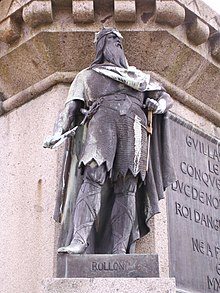Hrolf Ganger
| Gaange Rolf, Rollo | |
|---|---|

Rollo on the Six Dukes statue in Falaise town square.
|
|
|
Duke of Normandy Count of Rouen |
|
| Reign | 911–927 |
| Predecessor | None |
| Successor | William Longsword |
| Born | c. 846 |
| Died |
c. 930 Normandy |
| Burial | Rouen Cathedral |
| Spouse |
Poppa of Bayeux Gisela of France (intended, but unconfirmed) |
| Issue more |
William Longsword Gerloc |
| House | House of Normandy |
| Religion |
Norse Paganism later Roman Catholicism |
Rollo or Gaange Rolf; (Norman: Rou; Old Norse: Hrólfr; French: Rollon; c. 846 – c. 930 AD) was a Viking who became the first ruler of Normandy, a region of France. He is sometimes called the 1st Duke of Normandy. His Scandinavian name Rolf was extended to Gaange Rolf due to the fact that he as adult became too heavy for a horse to carry, therefore he had to walk ("gaa" in older Dano-Norwegian). Rollo emerged as the outstanding personality among the Norsemen who had secured a permanent foothold on Frankish soil in the valley of the lower Seine. Charles the Simple, the king of West Francia, ceded them lands between the mouth of the Seine and what is now the city of Rouen in exchange for Rollo agreeing to end his brigandage, and provide the Franks with protection against future Viking raids.
Rollo is first recorded as the leader of these Viking settlers in a charter of 918, and he continued to reign over the region of Normandy until at least 928. He was succeeded by his son, William Longsword in the Duchy of Normandy that he had founded. The offspring of Rollo and his followers became known as the Normans. After the Norman conquest of England and their conquest of southern Italy and Sicily over the following two centuries, their descendants came to rule Norman England (the House of Normandy), the Kingdom of Sicily (the Kings of Sicily) as well as the Principality of Antioch from the 10th to 12th century, leaving behind an enduring legacy in the historical developments of Europe and the Near East.
...
Wikipedia
